painting
drawing
print-making
rug design
O films
poetry
trigram press
writings
exhibitions
full list of works
home
|
a portrait of the artist
by rozemin keshvani
the pink house
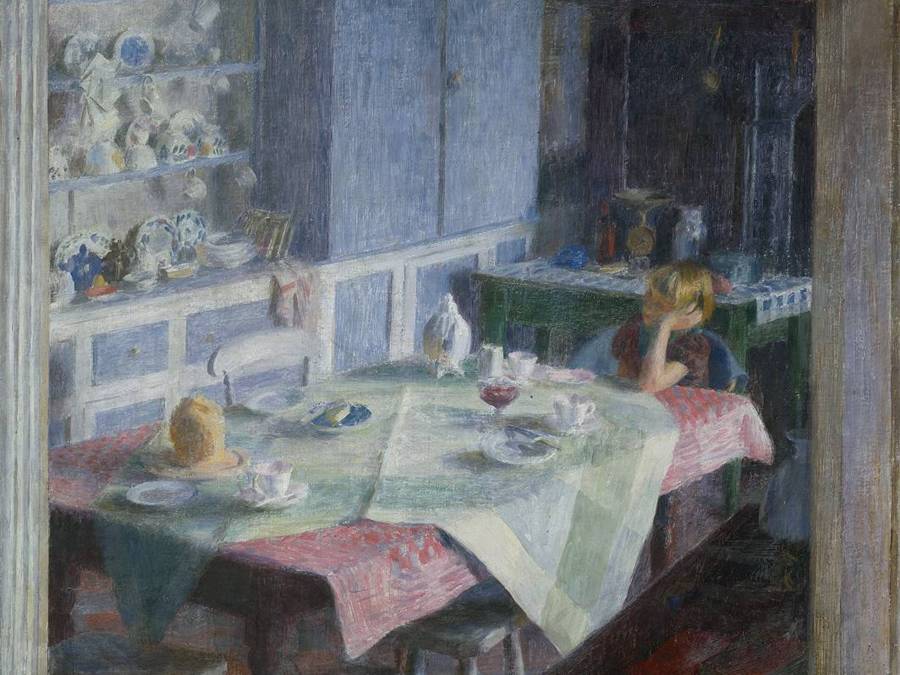
Benveniste was born in 1921 at Myrtle Cottage, a large pink-washed 18th-century house in Newlyn to a family of artists. Pip’s mother Kay Earle, was a painter out of the Newlyn School. Her father Alec Walker co-founded with Tom Heron, Cryséde, a company producing hand printed wood block designs for fine silks.
Pip’s upbringing was hardly typical. She lived among community of artists and writers with whom she studied and learned painting. She was immortalised in Dod Proctor’s painting Kitchen at Myrtle Cottage. She freely roamed the countryside, developing an intuitive appreciation of nature with its harmonious interdependence of forms and its patterns of degeneration and renewal. These early childhood experiences and Pip’s love and understanding of her physical surroundings would continually inform her work and shape the artist she would become.
a journey begins…
On the outbreak of the Second World War at the age of 18, Pip left home
to join a pacifist experimental community grounded in organic
agriculture. After the war, she moved to London. She became friends
with Lilian Wolfe who introduced her to anarchist philosophy.
Benveniste began reading every book she could lay her hands own and
meeting the London underground literati and activists associated with
the Freedom Bookshop in Red Lion Street. In 1949, Benveniste headed for
Paris. Here she became familiar with bohemian artists, poets and
writers associated with the Bar Verte, among them the writer James
Baldwin then exiled in Paris with whom she would become close friends,
Dorothea Tanning, Max Ernst and two publishers of Zero Magazine,
Themistocles Hoetus and the poet Asa Benveniste with whom she would
begin a long period of artistic collaboration and together establish
Trigram Press in 1965.
Eager and youthful, Benveniste was captivated by her new environment,
absorbing the avant-garde Paris art scene, attending literary events,
painting portraits and creating work from the surrounding landscapes.
After Paris, Benveniste travelled to Tangiers and New York studying
colour and painting landscapes which grew progressively expressionist
in colour.
She returned to the countryside, this time settling at Dutch Cottage in
Tenterden, Kent, where she embarked on a study of the space of the
canvas, looking beyond its representational field. Working with
landscape, au plein air, she discovered that the ‘spaces in between’
were never constant but were rather influenced in colour and texture by
what immediately surrounded it -- by its neighbouring subject --
leading her to begin a life-long investigation into colour and medium.
By1957, her paintings embodied bold movements in colour and lengthened brushstrokes, reflecting time spent in New
York and her experiments with abstract painting. On her return to
Britain, she aspired to expand the field of her practice, and to move
beyond servitude to the canvas.
In 1958, Pip returned to London making her home in West Hampstead where
she became part of London’s emerging avant-garde artist scene
influenced in part by Paris’s avant-garde and beat counterculture.
Benveniste collaborated with poets, writers and artists who sought to
make art relevant to life by moving out of the studio and on to the
street.
As an artist, Benveniste was fearless. She befriended the ‘bad boys’ of
the London art scene, collaborating and learning, while experimenting
with multiple media which took her practice far beyond the studio. This
period of unparalleled experimentation and collaboration that lasted
throughout the 1960s would prove an extremely influential and important
period in Pip’s development. These experiences would deeply affect her
subsequent work and have far-reaching implications to her development
as a painter, contributing to her unique understanding of colour and
time in painting.
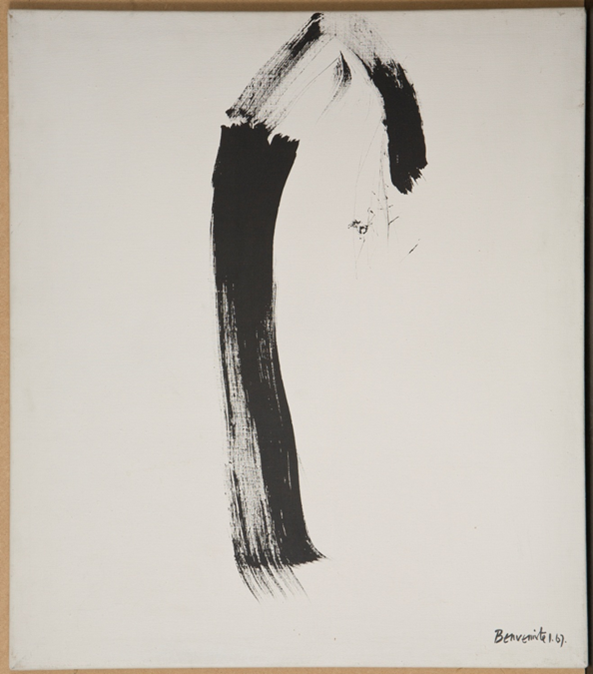 Benveniste
had her first solo show in May 1965 at the dynamic and defining New
Vision Centre at Marble Arch, London. Her work was controlled but
explored delineation of energy in space. She was now fully immersed in
abstraction and concerned to eliminate superfluous details and break
free of representational painting. She was determined to move beyond
oil painting, her medium for over 25 years, and she began experimenting
with acrylic. This lighter medium allowed her to work to take on
calligraphic and gestural qualities. She even began to make her own
brushes, smashing bamboo to a fringe and then elongating the brush with
a broom handle to create these gestural Benveniste
had her first solo show in May 1965 at the dynamic and defining New
Vision Centre at Marble Arch, London. Her work was controlled but
explored delineation of energy in space. She was now fully immersed in
abstraction and concerned to eliminate superfluous details and break
free of representational painting. She was determined to move beyond
oil painting, her medium for over 25 years, and she began experimenting
with acrylic. This lighter medium allowed her to work to take on
calligraphic and gestural qualities. She even began to make her own
brushes, smashing bamboo to a fringe and then elongating the brush with
a broom handle to create these gestural
paintings in her Camden studio.
painting and poetry
Benveniste’s painting was deeply influenced by poetry. She collaborated
with poets and writers throughout her life and her paintings often
expressed a poetic form. In the 1960s, at her Camden studio, Benveniste
began to develop her own unique style of an abstract
non-representational poetic in her painting. She was studying Taoist
philosophy through the I Ching, and also took inspiration from the
Japanese poet Matsuo Basho leading her to incorporate poetic forms and
build calligraphic strokes into her work in order to strive beyond representing the material in her work.
She worked on mastering the hand & arm gestures with large
brushed marks in black paint on white canvas. A very hard way of
painting as just one or two large marks had to be completely acceptable
to herself, and needing a lot of peace of mind and well being with the
large white canvas surface which incidentally could be ruined in a
second, costing a bit too.
As a painter, she was concerned to excavate the form of landscape, its idea, its energy. She was unmoved by
‘abstraction’ as such which she viewed as overly mathematical and out
of tune with the truth of the landscape she experienced. She sought to
work with a more organic form of abstraction, and to re-evaluate the
role of ‘time’ in her work, studying Jung’s theories of ‘synchronicity’
as meaningful coincidence and the relativity of psychic time.
Benveniste began to create a series of works in which the line meets
poetry. Sensual and calligraphic, these monochrome works present an
idea of abstraction that challenges the traditional canon, alluding to
landscape through a process which Benveniste felt to be more organic
and alive. She achieved these abstractions through a continued and
systematic sketch of a single scene or concept.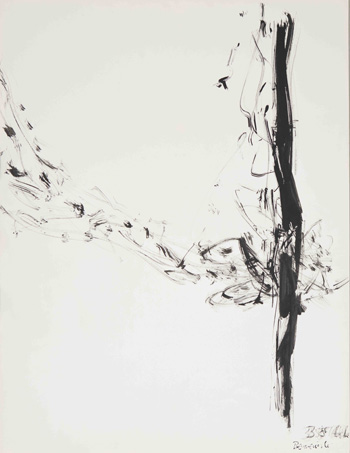
Benveniste would repeatedly draw her subject using a process of
successive abstraction in order to deconstruct and overcome mimetic
form, being careful not to treat this exercise as a form of reduction,
but instead focusing on the poetry within and between. She sought to
paint the raw energy of her subject matter as idea, as concept, by
reaching into liminal, non-material space, exploiting chance and
accident as part of her imaginative manipulation of paint.
Drawing was essential to Benveniste’s compositional technique and
process in painting. She took inspiration from Klee, of whom she often
spoke, allowing the pencil to wander and flow until becoming one with
the line. The artist was principally concerned to draw negative space.
Benveniste interpreted positive space to be subordinate. It would
follow once negative space was comprehended.
When speaking with her students, she would encourage them to view
a piece of furniture and then imagine the piece vanish, leaving only
the surrounding negative space. It is this negative space she would
encourage them to then paint. Benveniste sought to push the line to its
limits.
Benveniste began making films in 1967 as part of her move from the
studio to the street. Her first film EVENTUAL ultilised footage she
shot from the performances of John Latham, Stuart Brisley and Jeffrey
Shaw (Event Structure Research Group) to create a psychic
reinterpretation through film of what she understood these artist's
were trying to achieve in their event-based performance works. Pip’s
camerawork reveals the revolutionary nature and time-based structure of
the cinematic experience and the medium’s direct relationship to these
event-based performances. The soundtrack is atonal, disturbing,
industrial. Her camera reflects and amplifies the fluxus nature of
these happenings and her own investigations into ‘time’ as an element
in her work.
She used the camera to explore ideas about the relativity of psychic
time through her study the effects of non-linear composition and
juxtaposition of random interpolations. Repetition combined with
nonlinearity became a means of progressively abstracting an object’s
inherent force. Awareness of the subject is replaced by an awareness of
essential energy.
  
a study of the canvas
Working with film gave Benveniste a renewed appreciation of the
possibilities within the canvas and the grid itself. The artists began
to make a study of the canvas as more than mere supports for her
painting. Benveniste discovered that the canvas was potentially more
significant than the painting it supported.
No medium was passive. No support could be neutral. The canvas itself
was an active force in the work, governing the mode and structure of
presenting work. Paint could be applied so as to force the canvas into
an act of self-disclosure and to structure and reveal the truth of the
work.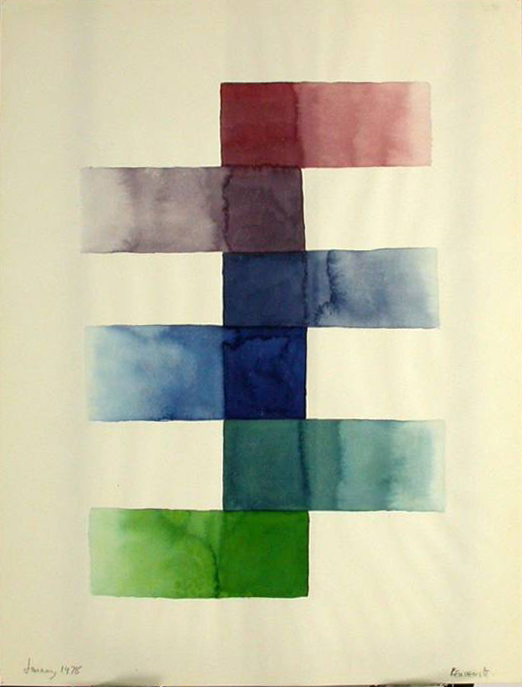
By the 1980s, Benveniste began to work more and more as a print-maker
and eventually became accomplished with etching and biting plates of
all types. The print became a new way of interpreting her theories of
colour and the dynamics of relatedness. The artist set up her own print
studio at Barrington
Road in Crouch End, producing aquatints and etchings. Etching provided
Pip with the means to embark on a deeper, and more precise, structured,
and systematic study of colour.
a return to painting
In 1996, Benveniste returned to the coast, this time settling at a
cottage in Dorset. She would once again re-focus her efforts toward
painting, bring her mastery of colour to the medium of watercolour. For
her, watercolour made possible a return to her roots and an encounter
with landscape that would allow her to integrate her now vibrant and
exploding palette with her ideas about time, organic abstraction,
dimensionality and drawing.
Benveniste had been interested in opposition throughout her practice.
She viewed negative and positive forces as coming together to create
each moment. She sought to find the harmony between the active ocean
and its seemingly passive recipient, the coast. She was interested in
the flux and flow of nature. The natural balance of light and dark and
achieving a balance between two opposite poles, revisiting her ‘groyne’
series, this time through watercolour.
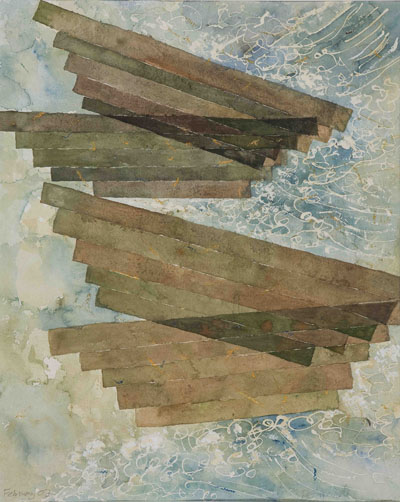
the influence of the coast
The artist’s childhood in her coastal home of Newlyn was a continued
source of inspiration throughout her life. And the coastal landscape of
Britain became a subject through which to explore her obsessions. The
poet Tony Ward has noted that Benveniste’s move to Dorset in the late
1990s was profoundly important:
Her
art changed significantly. Maybe she imagined she was back in Cornwall,
a place in which, I believe, her heart always resided, as her work made
a very brave move back to her own origins in Newlyn, Mousehole,
Penzance, St Just and St Ives. In these later watercolour paintings on
handmade papers, the colours became translucent and the images more
rural, with frequent references to the landscapes of her youth.Water in
all its forms would repeatedly appear in her work to depict emotional
energy and the idea of the landscape she experienced. She was
incredibly prolific, creating a vast and varied oeuvre. She would
continue to produce marvellous work until her death in 2010.
-Tony Ward
Benveniste‘s dedication to her craft can be seen at every stage of her
long and involved career, spanning every media from paint to printing
to her most innovative works in film and photography and even rug
design. Her involvements and collaborations with contemporaries place
her among an elite group of avant-garde and often radical British
artists who were searching for new ways of responding the experience of
life after World War II.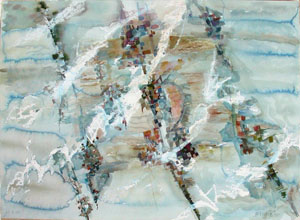
At her memorial, Professor Andrew Dewdney of London’s South Bank University honoured Pip with the following words:
Pip
Benveniste needs to be part of the story of 20th century British art.
When we think of Modernist Britain, we think a long list of men such as
Lucien Freud, Richard Hamilton, Henry Moore, Ben Nicholson, Victor
Pasmore or John Piper. Benveniste was all the more singular within
her generation in committing herself to being a full time artist. The
price that all artists pay for their singular purpose is, I suspect,
visited more painfully upon women artists…She clearly had a context,
and as happens with many good artists after their death, a deeper and
more rewarding revisiting of their legacy and struggle reveals
refreshed pleasures and new insights that allow us to validate again their journey and their place in history.
- Professor Andrew Dewdney
|